Schlesinger Race - 1936
-
1936 Schlesinger Race
The Schlesinger Race from Portsmouth to Johannesburg 1936

In December 1936, Flight Magazine summed up the outgoing year in aviation. Calling it "a satisfactory year" in general - "the public is much more interested in flying than it has ever been"... "the opening of Gatwick Airport was an event of importance", and so on - it continued: "On the sporting side we had the Schlesinger race in the autumn, but the less said about that event the better."
Only one of the 9 starters (of the original 14 entrants) made it to Johannesburg, and two people were killed during the Race.
Scott and Guthrie were met by a deafening silence on their return, and CWA Scott said "The race was a piece of complete nonsense... I'm glad we didn't make the return journey in a packing case". Their victory seemed a hollow one, and the unclaimed prize money - £6,000 out of the £10,000 total fund - went to the families of those who had died; £2,000 each to Mrs. Max Findlay and Mrs. A. H. Morgan and £2,000 placed in trust for the child of Capt. Findlay.
A rather sad and unloved affair, then; which is a pity, because it had begun with high hopes: "The success of the international air race to Melbourne gives us good grounds for welcoming an Empire air race from London to Johannesburg. Mr. I. W. Schlesinger is worthily following in the footsteps of Sir Macpherson Robertson."They hoped that "this race will enable the business men of the Union to study the [British] Empire's various landplanes, and judge for themselves which will be most suitable for the long internal stages, and which will be best for branch lines."
And after this race, the business men of the Union probably said "None of 'em".
The generous and well-meaning Mr Schlesinger deserved better.
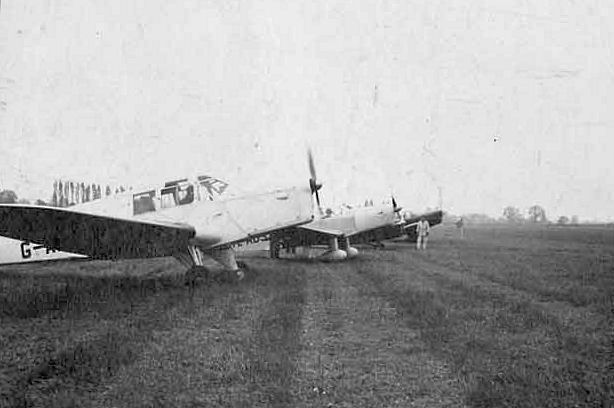
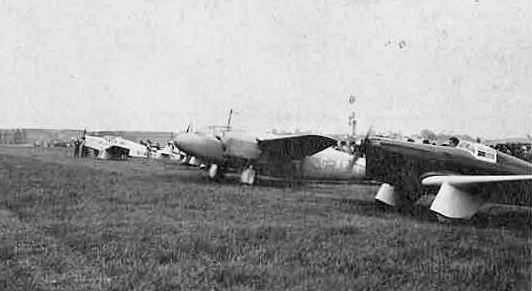
The story of the race, at a glance:
Mr I W Schlesinger was a South African industrialist who controlled about 70 companies covering theatres, films, and insurance.
Entries were restricted to 'aircraft and pilots from the British Empire'; the start (originally expected to be Hatfield) was from Portsmouth. The competitors took off starting at 06:30am (in semi-darkness) on Tuesday the 29th September 1936.
Scott and Guthrie left behind them a trail of broken aeroplanes all the way (6,150 miles) to Johannesburg, which they reached on Thursday the 1st October. Their flying time was 2 days 4 hr 56 min.
They all went to a celebration dinner at Claridge's after the race, which must have been fun:

As for the Arithmetic, there was a Handicap Formula, but even I can't work up much enthusiasm for it; suffice it to say it was a very-slightly modified version of the one used for the MacRobertson Race, and would have proved equally misleading if it had been needed, probably...
Race No
Aeroplane
Pilot(s) - click links for more Other Crew Result 1

Percival E.2H Mew Gull ZS-AHM 'The Golden City'
[Die Goudstad on this side]
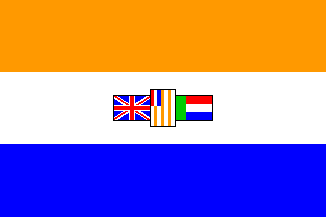
S.Africa

Maj Allister Mackintosh Miller Forced landing near Belgrade - fuel problem 2 
Percival Mew Gull ZS-AHO 'Baragwanath'
S.Africa

Capt Stanley Seward Halse Forced landing Mbeye Rhodesia 30 September 1936 - landed, in poor visibility, in a ploughed field and overturned Fifteen years later, the battered aircraft was still lying derelict at Johannesburg
3 .jpg)
Miles M.5A Sparrowhawk G-AELT
S.Africa

Victor C Smith Withdrew Khartoum - oil tank trouble earlier Victor later modified it to have an enclosed cokpit, and used it for air taxi work.
4 
B.A. Double Eagle IV G-AEIN

---

S.Africa

---

Tommy Rose
---
Jack Bagshaw
Withdrew Cairo - one of the undercarriage legs folded up while taxying 6 
Percival Vega Gull G-AEKE


---

Charles William Anderson Scott
---
Giles Connop MacEacharn Guthrie
Winner - in 2 days 4 hr 56 min 7 .jpg)
Percival P.10 Vega Gull G-AEAB


---

F/O David W Llewellyn
---
Charles F Hughesdon
Forced landing near Lake Tanganyika - weather
(the aircraft was written off)
8 .jpg)
Miles M.2U Hawk Speed Six G-ADOD

.jpg)
F/O Arthur Edmond Clouston Forced landing near Gwelo, Rhodesia on 1 October 1936 - engine trouble 10 
B.A. Eagle 2 G-ADID 'Frobisher'
"very much a sporting entry"
[this appears to mean 'complete amateurs']


---

Cyril Geoffrey Marmaduke Alington
---
Lt P A Booth, RN

Paymaster Lt Rupert Hildebrand Alington
Forced landing near Regensburg, Bavaria - the undercarriage was damaged by the rough ground 13 
Airspeed AS.6J Envoy 3 G-AENA 'Gabrielle'


---

Capt Maxwell Hutcheon Findlay
--
Mr Kenneth Herbert Fraser Waller
A H Morgan
(wireless operator)
---
C D 'Derek' Peachey
Crashed at Abercorn, Rhodesia 1st October 1936 - struck trees after take-off, killing Max Findlay and wireless operator A H Morgan Finishers: 1 (out of 9)
Did not start:
5 Percival Vega Gull G-AEKD 
Lt D Misri Chand Not ready in time - 
Lt Patrick Randolph
9 D.H. 92 Dolphin H Buckingham Development was abandoned after the prototype had flown at Hatfield 11 Miles M.8 Peregrine 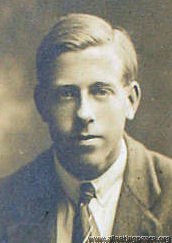
Flt Lt Hugh Robert Arthur Edwards Not ready in time -

Sqn Ldr B S Thynne 12 Percival Vega Gull VP-KCC 
John E Carberry
(Lord Carberry)
A/C damaged at the end of Beryl Markham's transatlantic flight 14 Percival Mew Gull G-AEKL 'Miss Liverpool I' 
Tom Campbell Black Damaged in fatal accident at Speke Airport - Tom Campbell Black killed -
-The Aviators
The Aviators
-
Alington, Cyril Geoffrey Marmaduke
Cyril Geoffrey Marmaduke Alington
.jpg) photo: 1933, aged 19
photo: 1933, aged 19
photo: 1936, aged 22
b. 19th August 1914 in Richmond, London, the youngest of four brothers.
Their father was Lt-Col Arthur Cyril Marmaduke Alington, and their mother was herself a pilot and had made parachute descents; they could trace the family back to William the Conqueror.
[The eldest brother, William James Marmaduke Alington (known as 'Marmie') was chief instructor at the Yapton Flying Club in 1937, and taught Lettice Curtis to fly.]
In 1933, a public schoolboy in Hythe, Kent; by 1936 a student at the de Havilland Technical School.
Competed in the Schlesinger Air Race in 1936, and came 12th (out of 15) in a Dart Kitten in the Devon Air Race in 1937:

"Mr CGM Alington, an entry in today's Devon Air Race, being greeted by Flt-Lt W E Knowlden on arrival last evening at Plymouth Airport" - Western Morning News, 24 July 1937
He joined the Air Transport Auxiliary in 1939 - see https://www.ata-ferry-pilots.org/index.php/category-blog-1939/77-alington-cyril
d. 1987
-
Alington, Rupert Hildebrand
Paymaster Lt Rupert Hildebrand Alington

Cyril's elder brother, b. Hythe, Kent 16 March 1911.
Killed in WWII: 10 September 1943, a Lt-Cmdr aboard the minelayer HMS Abdiel, which was mined at Taranto.
-
Bagshaw, Jack
Jack Bagshaw 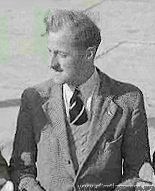
Accompanied Tommy Rose in the Schlesinger Race; described as 'a young South African pilot'.
That's it, so far; sorry.
-
Booth, P A
Lt P A Booth, RN
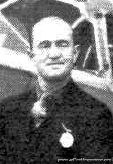
Accompanied Cyril Alington in the Schlesinger Race, attending to the "navigation and such duties".
A Supernumary Instructor at the School of Naval Co-operation, Lee-on-Solent.
-
Campbell Black, Tom
-
Chand, Dewan Misri
Lt Dewan Misri Chand
 in 1936
in 1936b. 11 October 1907
'Infantry Officer in the Indian Army who learned to fly with the Bombay Flying Club and has followed the sport with zest. He won the Viceroy's Cup Race in February, flying a hired Club Gipsy Moth, and came to England to have a shot at higher game.'
Also entered for the Schlesinger (Portsmouth - Johanesburg) Race in 1936, but the aircraft was not ready in time.
Later, a Major General.
d. 13 March 1970.
On 22 October 2009, the Indian Post Office issued a stamp in his honour.
-
Clouston, Arthur Edmond
F/O Arthur Edmond Clouston
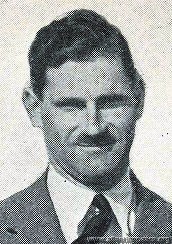 in 1936, aged 28
in 1936, aged 28Famous D.H. Comet pilot, from New Zealand. Civil Test pilot at RAE Farnborough in 1936. Flew Desoutters in other races.
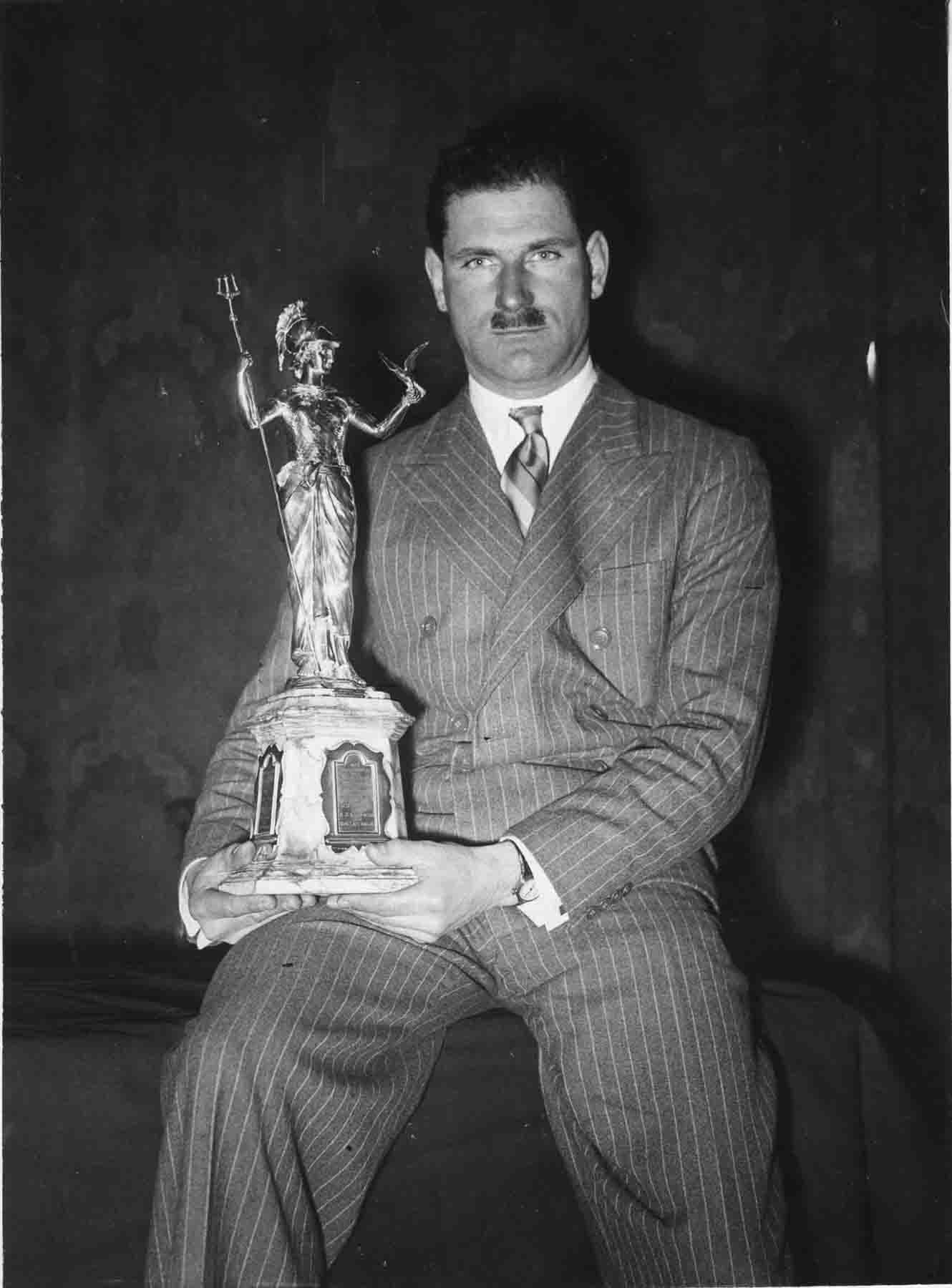 With the Brittania Trophy
With the Brittania Trophy© The Royal Aero Club [0654-0280]
d. 1984
-
Edwards, Hugh Robert Arthur
P/O (later F/O, Flt-Lt) Hugh Robert Arthur Edwards  1929, aged 23
1929, aged 23'Jumbo', the famous Oxford rowing coach, younger brother of Cecil
His grand-daughter's husband Gavin has written Jumbo's story, in four parts, starting here:
https://heartheboatsing.com/2020/02/17/jumbo-edwards-oarsman-coach-and-raf-pilot-part-i/
-
Findlay, Maxwell Hutcheon
Capt Maxwell Hutcheon 'Max' Findlay 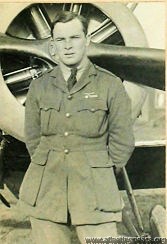
photo: 1918, when a Captain in the RAF, aged 20
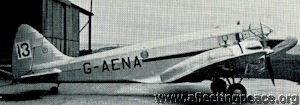
d. 1st October 1936, in the Schlesinger England-Johannesburg Race; the Airspeed AS.6J Envoy 3 G-AENA 'Gabrielle' struck trees after take-off and crashed at Abercorn, Rhodesia, killing Max Findlay and wireless operator A H Morgan.
The unclaimed prize money from the race - £6,000 out of the £10,000 total fund - went to the families of those who had died; £2,000 each to Mrs. Max Findlay and Mrs. A. H. Morgan, and £2,000 placed in trust for the child of Capt. Findlay.
-
Guthrie, Giles Connop MacEacharn
Mr Giles Connop MacEacharn Guthrie 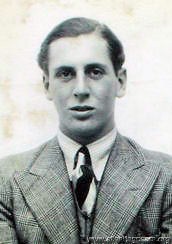 1935, aged 19
1935, aged 19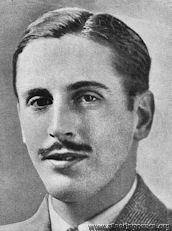 1936
1936Shown here, for comparison, just before, and just after, he grew his moustache.
"Giles Guthrie is the only son of Sir Connop and Lady Guthrie. His enthusiasm for flying has roused his father's active interest in the aviation industry. Only 20 years of age, he is the youngest pilot and the only undergraduate to take part in a long distance air race. For the Johannesburg race, the Cambridge University authorities gave him special leave of absence.
Despite his youth, he is a pilot of considerable experience. The Percival Vega Gull in which Charles Scott and he won the Johannesburg race, first tasted victory in the King's Cup this year. Giles Guthrie then flew as co-pilot with Charles E Gardner .
When Sir Connop decided to enter the machine in the Johannesburg race and chose Charles Scott to fly it, one condition was that Scott should take young Giles with him."
- from the Celebration Dinner programme after the race (October 14th 1936 at Claridge's Hotel).
Had used his Vega Gull for a "good deal of continental touring".
Later Sir Giles, J.P., merchant banker.
Died 1979
-
Halse, Stanley Seward
Capt Stanley Seward Halse  1915, when a Corporal, aged 23
1915, when a Corporal, aged 23 1936, aged 44
1936, aged 44 b. 6th December 1892 in Queenstown, South Africa.
b. 6th December 1892 in Queenstown, South Africa.Learnt to fly during WWI, and by 1936 was a flying instructor at the Johannesburg Light Plane Club. Two members (Rex Hull and George Albu) put up the £1,800 required to buy the Mew Gull to enter for the Schlesinger Race. Presumably, that was the last they saw of their money.
Stanley dislocated his elbow in the subsequent crash, and much later found out that three of his vertebrae had telescoped.
-
Hughesdon, Charles Frederick
Mr Charles Frederick Hughesdon 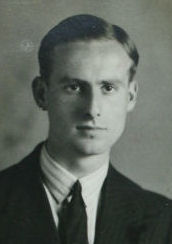 1933, aged 24
1933, aged 24Lloyds Insurance Broker; he married actress Florence Desmond after Tom Campbell Black's death.
Honorary Flying Instructor to the Insurance Flying Club at Hanworth
-
Llewellyn, David W
F/O David W Llewellyn .jpg) 1932, aged 28
1932, aged 28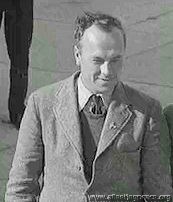 1936, aged 32
1936, aged 32b. 9 Aug 1904 in Wichelsea, E Sussex; son of the President of the Royal Academy.
An instructor at Hanworth.
With Mrs Jill Wyndham, broke the Cape Town-England record in 1935 (6 days 12hr 7min). [I say, who is this Mrs Jill Wyndham, and did Mr Wyndham know about this? *]
Apparently, they had intended also to lower the record for the outward trip. "... they were going strongly, but their chances were ruined by a forced landing in an African rice field. The aircraft was set down by the light of lamps carried by an Arab funeral procession."
He had also flown solo in a "little Aeronca" to Johannesburg, and here he is, in it:
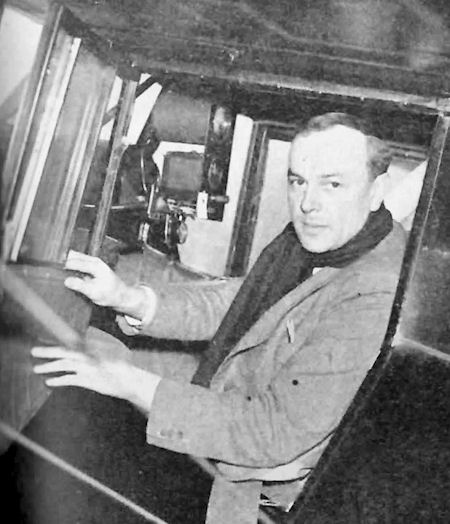
[To be more precise, in the 23 days between the 7th February and 1st March 1936, he flew from Hanworth to Rand Airport, Johannesburg, to deliver the machine to a private buyer. The 2-cylinder engine of an Aeronca produced 40hp.]
Killed 21 September 1938 in an accident in a BA Swallow.
[ *It seems that Doris Jillian Wyndham
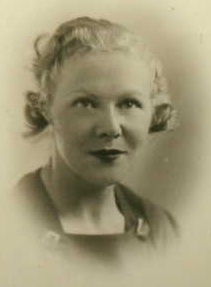
b. 11 May 1911,
was a former pupil of Mr Llewellyn. Or possibly of Tom Campbell Black, if we are to believe Harald Penrose.
Her son tells me that "she died in 1963 at the age of 52. Lt Cdr Wyndham did know about the record attempt!"]
-
Miller, Allister Mackintosh
Maj Allister Mackintosh Miller .jpg)
photo: 1915, when a 2nd Lieut, RFC, aged 23
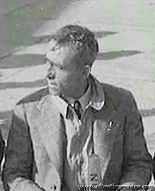
photo: 1936, aged 44
 b. 10 September 1892 in Scombeni, South Africa.
b. 10 September 1892 in Scombeni, South Africa.Known as 'Mac'; WWI pilot and founder of Union Airways, which was sold to the South African Government in 1934.
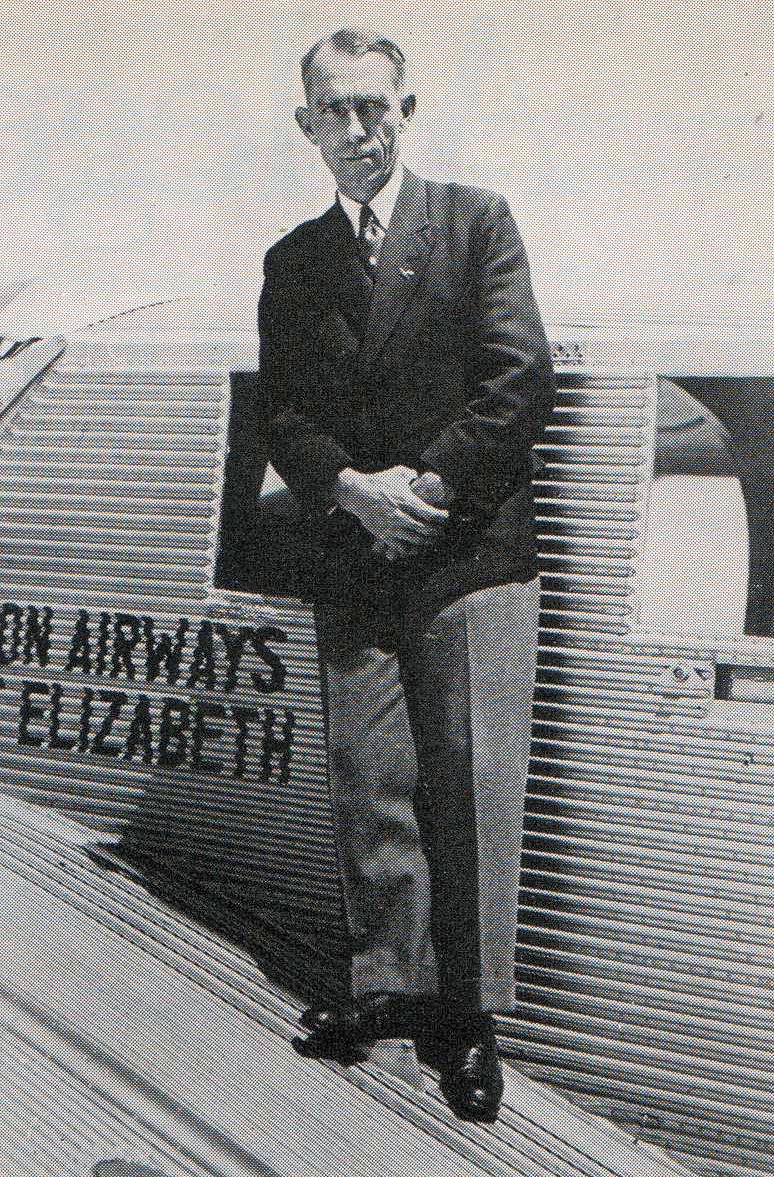
"One of South Africa's most famous aviation figures"
"A little incident which shows the sort of man Major Miller is happened at Gravesend a short time ago. Mac had just landed after flying the Mew Gull. He then told Capt. Percival that he did not like to tell him before, as he thought it might worry him, but except for a short flight in a Vega Gull he had not flown for two and a half years! "I knew it would be quite all right " was what he told Percival."
-
Randolph, Patrick
Lt Patrick Randolph  1933, when 2nd Lieut in the Grenadier Guards, aged 20.
1933, when 2nd Lieut in the Grenadier Guards, aged 20..jpg) in 1936
in 1936b 25 Jan 1912 in Chelsea, London.
His parents (American-born Arthur Bertram Randolph and Enid Saffron Pickersgill-Cunliffe) had made the society pages when they had a 'best girl' as well as a best man at their wedding in 1908.
However, his father was killed in WWI, his mother remarried (becoming Saffron Duberly, and 'lady of the manor' in St Neots) and in 1924 she and Mr Duberly sailed off to Jamaica, leaving the 12-year-old Patrick to go with his aunt Adelaide to the USA, presumably to visit family (his grandfather Arthur Randolph Randolph had emigrated and died there in 1885).
It seems that Patrick subsequently lived with his aunt Adelaide and her husband Lionel in Dorset - he always quoted their address as his own, and again visited the USA with her in 1935.
In December of 1933, he and fellow-officer Capt Goschen flew (in Pat's Percival Gull) to Egypt to take up an appointment at the Flying School for 2 years. Whilst there, he took part in the 'Oases Circuit Air Race' along with 31 others from Britain, France, Germany, Italy, Jugoslavia, Sweden and Belgium.
He "sportingly flew up for the race round the Isle of Man in 1936 during 48 hours leave and flew back the same night".
He took part in several other races, e.g. the Folkestone Air Trophy in August 1933; the London-Cardiff Race in 1936, and the Manx Air Race in June 1937. He entered for the Schlesinger Race in 1936 (as co-pilot to Lt Misri Chand) but the aeroplane wasn't ready in time.
He owned 4 aeroplanes:
- G-AACV, a 1928 Avro Avian IVM;
- G-ACJW, a 1933 Percival Gull which was sold in Australia in 1934 and became VH-UTC;
- G-ACUL, a 1934 Gull Six (sold in New Zealand, becoming ZK-AES), and finally
- G-AEKD, a 1936 Vega Gull.
It was this aircraft in which he was killed in a crash in Jaipur, India on 12 October 1937, aged 25. P Q Reiss (q.v) was also seriously injured in the same accident.
A few weeks before his death, he and his uncle-in-law Lionel had been the joint executors for the will of his father's half-brother, Judge Joseph Randolph J.P., selling Eastcourt Estate ('A Georgian house with 484 acres, garages, stabling, and 9 cottages').
(His mother Saffron's son by her second marriage was also killed, in WWII. Her second husband died in 1951; she herself died in 1980).
-
Rose, Thomas
Flt-Lt Thomas 'Tommy' Rose DFC 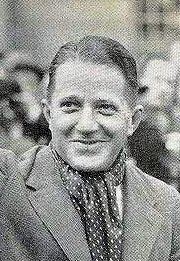 1936
1936b. 27 Jan 1895 - Alton, Hants
One of the best-known racing and pioneering pilots of the 30s.
His father, John, was a farm bailiff at Basing Farm, Froxfield, nr Petersfield, Hants. After working briefly as a bank clerk, Tommy joined the Royal Navy in 1914 and then transferred to the R.F.C. in June 1917.
"He was shot down three times, but escaped each time. He was awarded the DFC for his work with the fighter squadron in which Billy Bishop, VC, served. "
m. 1925 Margaret Elizabeth [Ashford], [divorced 1938]
Retired from the RAF in 1926 with the rank of Flight-Lieutenant.
In December 1931, he made an unsuccessful attempt on the UK-Cape record, and then flew back "by easy stages".
From Oct 1933, Manager and Chief Instructor at Sywell.
"TOMMY ROSE is gone from Sywell, but not forgotten. As sales manager for Messrs. Phillips and Powis, the Reading aircraft manufacturers, he spends quite a lot of time flying round the country. Last week his photograph was 'splashed' in all the national daily papers, greeting Mr. H. L. Brook, the Yorkshireman airman, on his arrival at Croydon after breaking the Australia-England record previously held by Jim Mollison. There was no mistaking Tommy’s famous sports jacket and boyish grin!
Mr. Rose, the way, left a last impression at Sywell. Shortly before leaving, when the new gate was being erected in front of the clubhouse, he carefully placed his foot in the wet cement and printed beside it 'Tom Rose' with a trowel. The cement hardened, and the 'Rose' mark is there for posterity to reverence! Hundreds of feet have since trod the hallowed spot." - Northampton Mercury, 12 April 1935
Competed in the King's Cup six times, winning it in 1935...
![Kings Cup 1938 Tommy Rose [0122-0170]](/images/gallery/air%20races/preview/333s333/Kings%20Cup%201938%20Tommy%20Rose%20%5B0122-0170%5D.jpg)
© The Royal Aero Club [0122-0170]
... and coming second in 1934 and 1936.
[The 1935 King's Cup itself recently sold at auction for £3,900:

Photo kindly supplied by Sarah Chambers, reproduced by kind permission of Sworders Fine Art Auctioneers.]
He became a national hero in March 1936 after his flight to Cape Town and back; "he can now claim to have made the fastest time for the trip both out and home. His new record is 6 days 6 hr. 57 min. (he got to the Cape in 89 hr. 37 min.), which beats F/O David Llewellyn's time—the previous best—by 5 hr. 6 min."
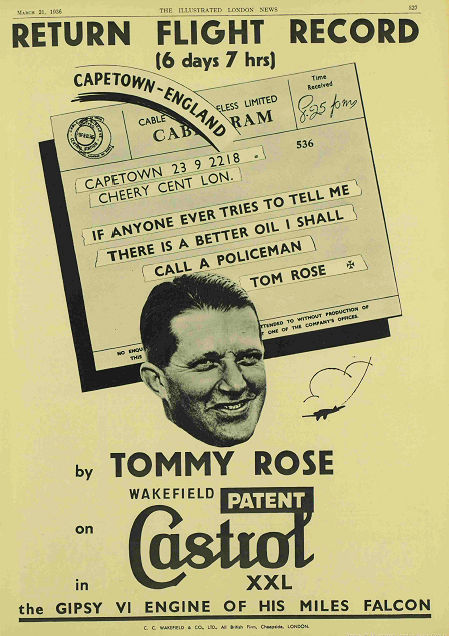
After the flight to the Cape, he had tea with the Prime Minister, General Hcrtzog, and also saw General Smuts. However, he was charmingly modest about his achievements:
"TOMMY ROSE ON LONG FLIGHTS
SAYS RECORD ATTEMPTS ARE 'LARGELY BUNKUM'
This flight business is bunkum! The authority for that picturesquely phrased piece of information is Flight- Lieutenant Tommy Rose, and he should know, for he hit the headlines in all the national newspapers when he smashed all records for the flight from London to the Cape. In a talk to the Round Table at Stewart's Cafe on Monday he summed up the whole business in these few words: 'All long distance flights are largely bunkum. The national newspapers, if there is no other news at the time, whip up an interest in these flights, and if one gets there safely and breaks a record everyone thinks: 'By gad, here's one of the twelve apostles come to life!’ (Laughter.)
'But I assure you there is nothing in it. The only things you have got do to be successful are to get the best machine you can find and then practise sitting still for a long, long time . . . . '
Reflections wise and witty on flying in general and his own flight in particular made Flight-Lieutenant Rose's talk one of the most delightful and amusing to which Tablers have listened to for a long time. His racy manner produced a laugh at almost every sentence, and a more unassuming world record breaker than this genial young man would be difficult to find.
There was one richly humorous story which is worth repeating. 'When I eventually got to the Cape I had to broadcast to the Union,' he said. 'The announcer seemed very nervous and this was what he said: ’Who do you think I have here the studio? None other than Mr Tom Mollison, who flew from London to the Cape in 37 days 18 hours.’ I met General Hertzog few days later and he said: 'if it takes all that time to fly, don't you think you had better come by boat next time?’
Flight-Lieutenant Rose answered a number of questions and urged the need for municipalities laying down landing grounds for aircraft. Members of the Rotary Club and of other Round Tables were present, as guests, to hear the airman’s talk. " - Eastbourne Gazette, 6 May 1936
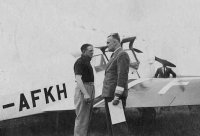
© The Royal Aero Club [0129-0039]
Before the 1936 Schlesinger Race to Johannesburg, he predicted: "It is my opinion that the pilot of the aeroplane which gets there in under forty-eight hours will deserve just about the biggest bunch of bananas ever found.
Having got lost myself many times down this route when flying without wireless, I fully expect to do so again, and the pilot in this race who can honestly say at the end that he was sure of his position all the time will either be very lucky, very clever, or have a queer idea of honesty."
From 1939 to 1946, Chief Test Pilot for Miles Aircraft, living in Sonning, Berks; in July 1943 he was reported to have "improved considerably and to be well on the way to recovery, after he contracted a chill when captaining his works cricket team. "
Won the Manx Air Derby in 1947, still flying a Miles Hawk; three circuits of the island at 181 mph.
d. 20 Jun 1968 - Alderney, Channel Islands.
-
Scott, Charles William Anderson
Mr Charles William Anderson Scott 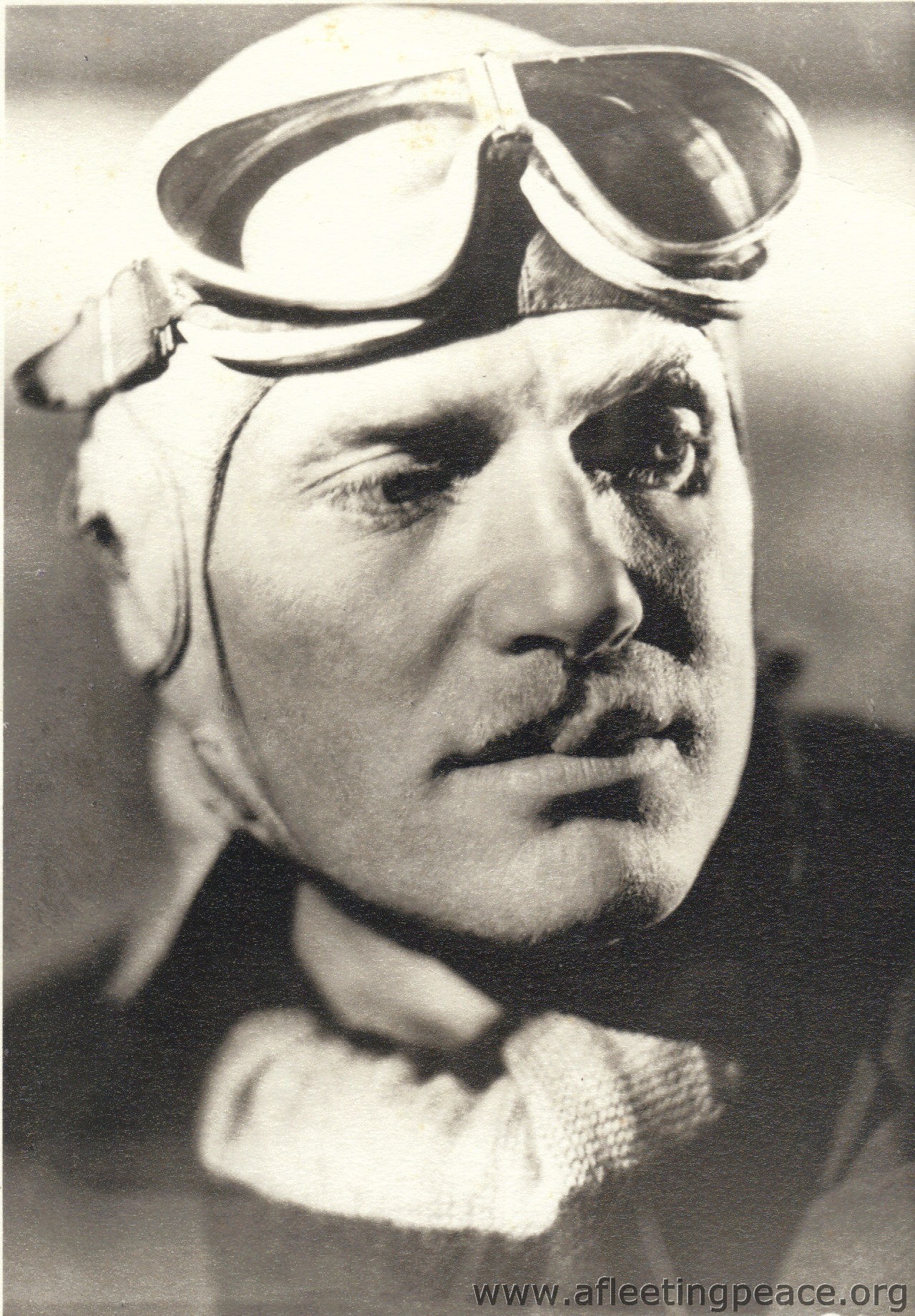
photo: 1934, aged 31
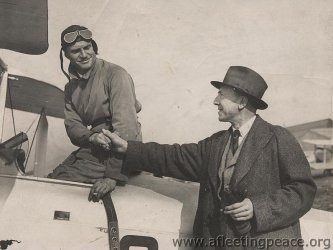 with his father Charles
with his father CharlesBorn 13thFebruary 1903 in London
One of the truly great aviators of the 1930s, establishing many long-distance records and winning some of the most important long-distance races of the period, but rather went to seed after that and shot himself after WWII. Scott wrote a book, and enterprisingly called it 'Scott's Book'.
"Scott is a splendidly-built six-footer, always in excellent condition. His other sporting recreations are golf and sailing."
"Charles Wiliam Anderson Scott, aviation editor of the 'News Chronicle', is the elder son of Mr Charles Kennedy Scott, the musician and conductor.
Educated at Westminster School, the future airman began his career as a sugar planter in Demerara, South America. The experience did not prove at all to his liking and he returned to England in 1922. Sailing was his passionate hobby - it still is - but as a youth trying to find his rightful career, flying did not occur to him until a friend suggested joining the Royal Air Force. Young Charles Scott sent in his application and thought little more about it until he found himself accepted and ordered to report to the Flying School at Duxford.
The Royal Air Force occupied the next four years of his life [he was heavyweight and light-heavyweight boxing champion whilst in the RAF] and in 1926 he was again wondering what was the next move when chance played the deciding game again. A sharp shower of rain sent him scurrying into Australia House for shelter with the result that he was bound for Australia not many weeks later.
There Scott became a pilot with Qantas Ltd., flying the mail routes in Western Queensland and acting as a flying instructor from 1927 to 1930. During that period he met the late Bert Hinkler, Mrs Mollison and the late Sir Charles Kingsford Smith and was inspired to break records.
Scott resigned his flying job in Queensland and came to England in 1931 determined to break the England-Australia record, despite accumulating financial troubles caused by the rising Australian rate of exchange.
He got there, reducing the record to 9 days 3 hours. That year he flew back again and made another record of 10 days 23 hours. Both flights beat Sir Charles Kingsford Smith's times.
In 1932 he attacked the England-Australia record for the second time and regained it with 8 days 20 hours.
The greatest adventure of his career was the magnificent flight in the Mildenhall-Melbourne air race of 1934 when he and the late Tom Campbell Black reached Melbourne in just under 3 days.

On September 17, Scott was married to Miss Greta Bremner, younger daughter of Mr and Mrs E L Bremner, of Melbourne, Victoria, Australia, only 12 days before the start of the Johannesburg air race."
- from the Celebration Dinner programme after the race (October 14th 1936 at Claridge's Hotel).
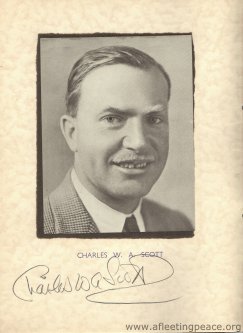
In 1936, his "Flying for All" Display embraced over 150 centres in the United Kingdom and Irish Free State, and was aimed particularly at "familiarising people with some of the cheap, easy-to-fly light aeroplanes available to-day".
Died 15th April 1946, in Germany, aged 43
.jpg)

p.s. The £10,000 MacRobertson first prize would, using average earnings, be worth about £2 million today.
-
Smith, Victor C
Victor C Smith  1936, aged 23
1936, aged 23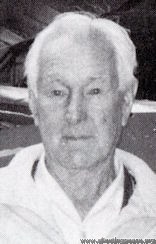 2000, aged 86
2000, aged 86Made several flights through Africa in record-breaking attempts, but his "pluck... exceeded his luck".
For example; in 1932, aged 19, he took off from Cape Town in a DH Moth, to try to break the record to London. He missed breaking the record by a few days, having been delayed by a 'run-in' with some fierce members of the Toureg tribe in the Sahara. He got out a cup of water and a packet of liver salts and drank the foaming liquid; such a man, they thought, must have supernatural powers, so they let him go.
Reaching London eventually, he then swapped the Moth for a Comper Swift and tried to fly back, but suffered engine failure; this time he had to walk 80 km through the Sahara. You'd think that would be it, but no: he found another aeroplane and continued south, only to run out of fuel just short of Cape Town.
In all, he made 21 forced landings during his flying career, all without serious injury. He wrote a book of his experiences, called 'Open Cockpit over Africa'.
In 1936, "Victor Smith was the most enthusiastic person at Portsmouth, and was obviously deeply in love with his Sparrowhawk". Aaaah.
Became a flying instructor after the race, then in WWII flew Beaufighters in Yugoslavia.
Page 1 of 2


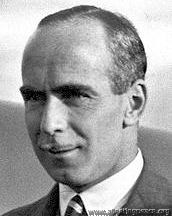 photo: 1934
photo: 1934
